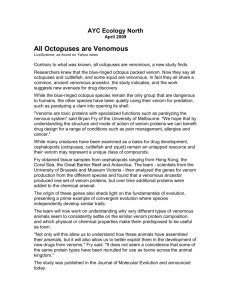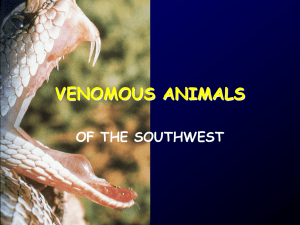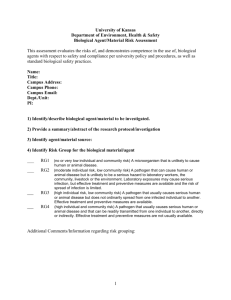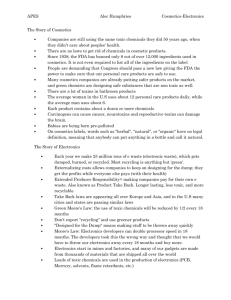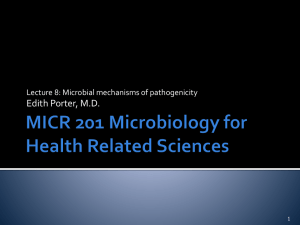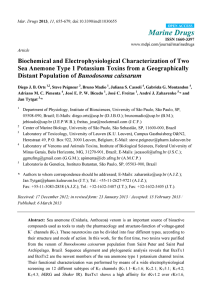Toxins
advertisement
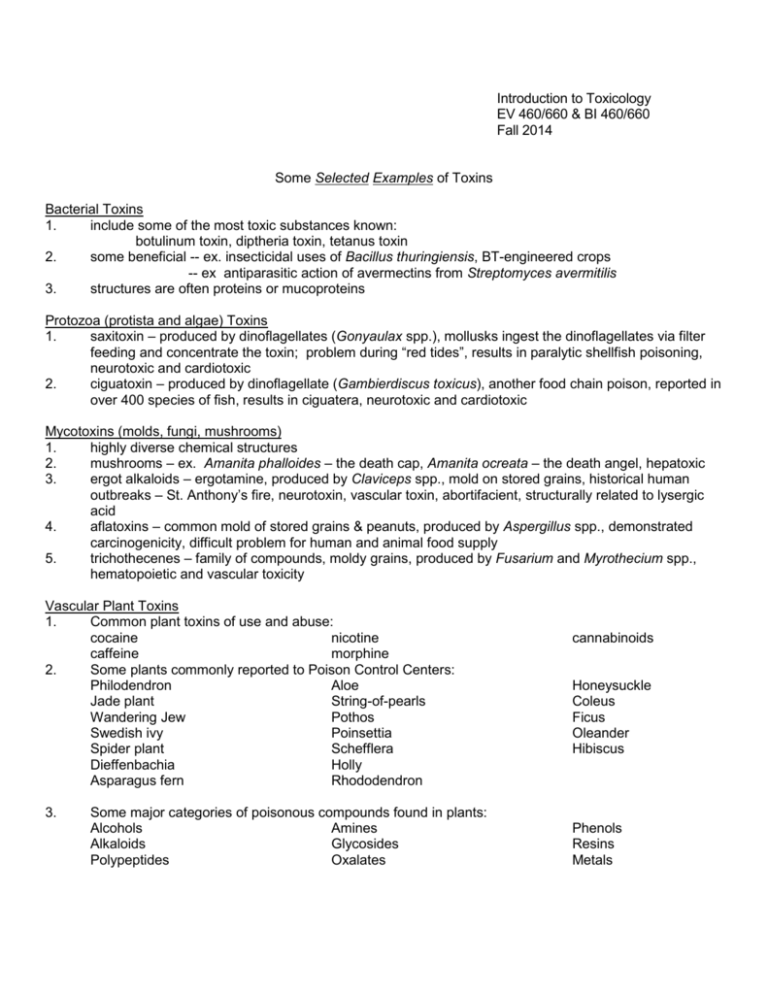
Introduction to Toxicology EV 460/660 & BI 460/660 Fall 2014 Some Selected Examples of Toxins Bacterial Toxins 1. include some of the most toxic substances known: botulinum toxin, diptheria toxin, tetanus toxin 2. some beneficial -- ex. insecticidal uses of Bacillus thuringiensis, BT-engineered crops -- ex antiparasitic action of avermectins from Streptomyces avermitilis 3. structures are often proteins or mucoproteins Protozoa (protista and algae) Toxins 1. saxitoxin – produced by dinoflagellates (Gonyaulax spp.), mollusks ingest the dinoflagellates via filter feeding and concentrate the toxin; problem during “red tides”, results in paralytic shellfish poisoning, neurotoxic and cardiotoxic 2. ciguatoxin – produced by dinoflagellate (Gambierdiscus toxicus), another food chain poison, reported in over 400 species of fish, results in ciguatera, neurotoxic and cardiotoxic Mycotoxins (molds, fungi, mushrooms) 1. highly diverse chemical structures 2. mushrooms – ex. Amanita phalloides – the death cap, Amanita ocreata – the death angel, hepatoxic 3. ergot alkaloids – ergotamine, produced by Claviceps spp., mold on stored grains, historical human outbreaks – St. Anthony’s fire, neurotoxin, vascular toxin, abortifacient, structurally related to lysergic acid 4. aflatoxins – common mold of stored grains & peanuts, produced by Aspergillus spp., demonstrated carcinogenicity, difficult problem for human and animal food supply 5. trichothecenes – family of compounds, moldy grains, produced by Fusarium and Myrothecium spp., hematopoietic and vascular toxicity Vascular Plant Toxins 1. Common plant toxins of use and abuse: cocaine nicotine caffeine morphine 2. Some plants commonly reported to Poison Control Centers: Philodendron Aloe Jade plant String-of-pearls Wandering Jew Pothos Swedish ivy Poinsettia Spider plant Schefflera Dieffenbachia Holly Asparagus fern Rhododendron 3. Some major categories of poisonous compounds found in plants: Alcohols Amines Alkaloids Glycosides Polypeptides Oxalates cannabinoids Honeysuckle Coleus Ficus Oleander Hibiscus Phenols Resins Metals 4. Some specific examples of plant toxins: plant castor bean (Ricinus communis) poison ivy (Toxicodendron radicans) stinging nettle (Urtica urens) foxglove (Digitalis purpurea) oleander (Nereum oleander) mistletoe (Phoradendron tumentosum) several (Strychnos spp.) larkspur (Delphinium barbeyi) locoweed (Astragalus lentiginosus) hellebore (Veratrum californicum) toxic compound toxic effect ricin GI toxicity urushiol contact dermatitis histamine, ACh, 5-HT contact dermatitis digitalis cardiotoxin oleandrum cardiotoxin phoratoxin cardiotoxin curare neurotoxin methyllycaconitine neurotoxin swainsonine neurotoxin cyclopamine teratogen Animal Toxins 1. representatives found in nearly all animal phyla; used both defensively (protection from predators and aggressors) and offensively (food-getting and facilitation of digestion), may result from food-chain accumulation (ex. Ciguatera fish) 2. “venomous” usually applied to species producing toxin in specialized exocrine secretory gland or cells and capable of delivering the toxin by biting or stinging often via specialized body parts. “poisonous” usually applied to animals whose tissues are, in part or whole, toxic and lack specialized structures for delivery of the poison. 3. diverse chemical structures and often mixtures: proteins (both high and low molecular weight), amines, lipids, steroids, aminopolysaccharides, quinines, 5-HT, glycosides, and others Arthropoda 1. approximately 1 million arthropod species, but only a few thousand are sufficiently venomous to be dangerous to humans, arthropods are responsible for more human poisonings than all other phyla combined 2. highly diverse chemical structures of the toxins 3. Spiders – over 200 species responsible for significant toxic bites of humans, familiar examples include: widow spiders – 5 species, including the black widow spider – venom is a mixture of proteins and is a neurotoxin; violin spiders – 100 species, including the brown recluse – venom is a complex mixture of proteins and other constituents and is a hemotoxin, vascular toxin, and causes tissue necrosis 4. Scorpions – 75 of the 800 species are sufficiently toxic to be of human concern, high incidence of stings and fatalities in areas such as the southwestern United States and Mexico. 5. Hymenoptera (bees, wasps, hornets) – responsible for more deaths in the United States than all the bites and stings of all other venomous creatures; particularly dangerous to sensitive individuals that may show acute anaphylactic reactions, venoms are complex mixtures of proteins (both enzymatic and non-enzymatic) and amines. Porifera (Sponges) 1. compounds appear to be defensive secretions against predators, human poisoning occurs primarily due to skin abrasions and produces contact dermatitis and pain, rarely systemic Cnidaria (Coelenterates) – hydroids, jellyfish, sea anemones, corals 1. stinging unit of cnidarians is the nematocyst- used both defensively and in food-getting, over 9000 species with nematocyts, approximately 100 species have been involved in human injuries, the Portuguese man-of-war jellyfish is a familiar example Echinodermata – starfish, sea urchins, sea cucumbers 1. venom apparatus is the pedicellaria, primary human poisoning is through puncture wounds; some human injuries, but rarely fatal Mollusca – see also paralytic shellfish poisoning 1. two (Gastropoda and Cephalopoda) of the five classes contain the majority of venomous species 2. Gastropoda (snails and slugs) – most dangerous gastropods are in the genus Conus (approximately 400 species) largely restricted to tropical and subtropical marine habitats, cone shells primarily use venom as an offensive, food-getting weapon, the venoms have not been well characterized, but appear to be a relatively low molecular weight proteins with paralytic, neurotoxic effects, some impacts on humans, but usually not fatal 3. Cephalopoda (cuttlefishes, squids, nautiluses, and octopods) – venom is an offensive, food getting weapon and is an integral part of the digestive process (e.g., venom also acts as a digestive enzyme), venoms are highly complex mixtures of proteins, carbohydrates, and amines, some impacts on humans, but usually not fatal Fishes – see also ciguatera 1. includes both poisonous (> 700 species) and venomous (>200 species) species 2. Tetrodotoxin (TTX) as an example toxin -- present in puffers, ocean sunfishes, and porcupinefishes (also in some salamanders and one octopus), commonly known as puffer or fugu poisoning, highest concentration of the toxin is found in liver and gonads, fugu chefs are licensed in Japan - despite this there are numerous deaths annually, a potent neurotoxin that has become a research tool of neurobiologists 3. venomous fishes – include stingrays, scorpionfishes, stonefishes, toadfishes, some sharks and catfishes, and other species, diverse chemical structures to the toxins, venomous species are often non-migratory, slow swimmers found in protected habitats (rocks, reefs, kelp beds), venoms are primarily used as defensive weapons, human injury is common, but fatalities are rare. Amphibians 1. approximately 2600 species divided into Anura (frogs and toads) and Urodela (salamanders and newts), many species are known to be poisonous, but very few are of danger to humans 2. toxins are produced in cutaneous secretory glands for defensive protection against predators, some evidence for anti-bacterial actions also; diverse chemical structures 3. some example toad toxins are: bufotenin, bufotenidin and bufoviridin, these are vascular, cardiac, and neurotoxins 4. among frogs, species of Phyllobatis and Dendrobates are the most poisonous 5. Batrachotoxin (BTX) – an example frog poison, very highly toxic alkaloid, a potent neurotoxin that has become a research tool of neurobiologists Reptiles 1. perhaps the most studied group, maybe due to deep-rooted human emotional responses to venomous snakes. 2. approximately 3,500 snake species, 400 snake species are sufficiently venomous to be dangerous to humans 3. a selective, partial list of venomous snake groups: Elapidae – cobras, kraits, mambas, coral snakes Hydrophiidae – sea snakes Viperidae – old world vipers and adders Crotalidae – rattlesnakes, water moccasins, copperheads, fer-de-lances, bushmasters Colubridae -- boomslang 4. snake venoms are complex mixtures, chiefly proteins, a number of which have enzymatic activity, some venoms are rich in proteases and responsible for marked tissue destruction, generally the actions are as hemotoxins, vascular toxins, and neurotoxins 5. lizards – two venomous species – the Gila monster (Heloderma suspectum) and the beaded lizard (Heloderma horridum), less dangerous than believed – slow moving and nocturnal, relatively few human injuries Birds 1. toxic quail ???, myths regarding raptors Mammals 1. relatively few species are poisonous or venomous 2. Australian duckbill platypus (Ornithorphynchos anatinus) males have venom glands associated with spurs on hind legs, venom is typically used in intraspecific competition, a few human injuries have been described. 3. Spiny anteaters (Tachyglossus spp. and Zaglossus spp.) have venom apparatus similar to the platypus 4. the short-tailed shrew has toxic and anti-coagulant secretions present in saliva, the venom has not been well characterized, but is thought to resemble the neurotoxin of elapid snakes 5. polar bears, walrus, and some seal species have livers that are very high in vitamin A, toxic hypervitaminosis A from ingestion of liver has been reported, other body tissues are safe
